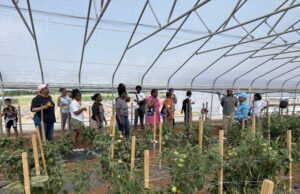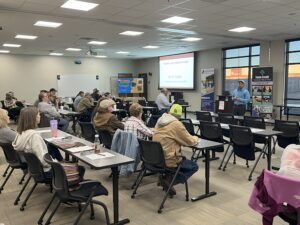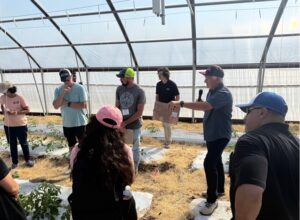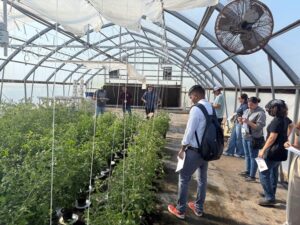Progress report for LS24-392
Project Information
In Oklahoma and Texas, tomato is grown during Spring and Summer seasons in the open field. However, due to the tight growing window, offseason and early production are necessary to be competitive before tomatoes from other States and countries reach the local market. In the open field, tomato is transplanted during mid to late April in Oklahoma and the first half of March in Texas with the high risk of damaging chill weather conditions. Furthermore, high temperatures during the growth cycle starting at the second half of May negatively affect flowering, and fruit setting reducing yield and quality in tomatoes in both states. Furthermore, insect pests and disease pressure represent a major constraint for open field production. To avoid unfavorable growing conditions, permanent protected structures such as greenhouses can be used, however high initial investment, and long-term commitment prevents growers to utilize this system. As an alternative, cost effective structures such as high tunnel, and micro-tunnel could be utilized. High tunnel and micro-tunnel allow season extension and early growth when outside environment is not favorable, therefore allowing local producers reduce production risks, increase yield, improve quality, and reach the market before other production regions to get a premium price. In addition, high tunnels allow the optimization and efficient use of resources such as mulching, irrigation, and fertilization. This project aims to evaluate high tunnel and micro-tunnel production systems in Oklahoma and South Texas. The project aims to identify the best planting dates and cultivars to reach high sale price windows. Economic feasibility analysis and field days will be performed as a decision tool for farmers to disseminate findings and to promote tomato production in the Southwestern region of US. Outputs from this project are expected to provide alternate ways to increase the productivity and profitability of the production system to the limited resources, small and minority farmers, and stakeholders.
The main goal of this project is to develop cost effective, high yielding, profitable production systems under high tunnel and micro-tunnel conditions.
Objective 1 Evaluate yield, quality and production efficiency of tomato cultivars under high-tunnel production systems in Oklahoma and South Texas.
Objective 2 Determine optimal planting dates and cultivars for tomato micro-tunnel production under protected structures to reach high price market windows.
Objective 3 Evaluate economic feasibility of micro-tunnel, and high tunnel production in Oklahoma and South Texas conditions.
Objective 4 Disseminate findings to promote tomato production.
Cooperators
- - Producer
- - Producer
- - Producer
Research
The study will be performed at two locations in Centra Oklahoma and the RGV in South Texas. High tunnel studies will be performed in high tunnels available at Langston University, OK, and Texas A&M AgriLife Research and Extension Center, Weslaco, TX. High tunnel located at the Horticulture Education Research and Extension Center (HERC), LU, in Langston, Oklahoma (measuring 96' x 33' x 10') will be used. In Texas A&M AgriLife, Weslaco, available ~2,000 ft2 high-tunnel structures covered with a single polythene film roof (6 mil poly cover) and a drop-down curtain (6 mil poly cover) sidewall system to passively control temperature. The sides of the structure are also covered with 50-mesh screen to reduce insect pressure. In both locations, available greenhouses will be used for raising the tomato seedlings for transplanting. Planting dates and cultivar evaluation will be performed simultaneously by location to determine best production practices.
Objective 1:
Tomatoes will be planted in high tunnel during spring season in Oklahoma and winter at South Texas. Six tomato cultivars including beefsteak, and cherry type will be evaluated. Commercial checks and specialty tomato cultivars developed by tomato breeding program at Texas A&M will be included in both locations. Seedlings will be grown in greenhouses and transplanted after ~5 weeks in the second week of October in Texas, and in second week of March in Oklahoma. Cultivars will be replicaed four times in Randomized Complete Block Design (RCBD).
Maintaining optimal environmental conditions within the high tunnel will be a priority throughout the growth cycle. Weather stations placed within the structure will monitor temperature and humidity levels. If external temperatures are predicted to fall below 50°F, all side walls will be closed to control temperature. During transplanting and early crop establishment in spring in Oklahoma, if external temperatures are anticipated to drop below 44°F, supplementary heating will be implemented. When outdoor temperatures are within the above mentioned threshold temperatures, high tunnel rollup side walls will be opened for aeration. To mitigate the temperature build up inside the tunnel during summer months in Oklahoma, in first week of May, roof of the high tunnel will be covered with black-colored 25% shade cloth. During period of rainfall and high wind conditions, side walls will be closed to minimize the effect of those factors to the plants inside the high tunnel.
In order to optimize production, inputs such as mulching, water-use efficiency, fertigation, and management of insect pests and disease will be adopted as needed. Moisture level in the plots will be sensed through watermark® sensors (Irrometer company, CA). Sensor probes will be used to sense moisture from 6”, 12”, 18” and 24” depth of soil. Sensors data will be recorded using Watermark datalogger (Irrometer company, CA). Average of the sensors reading will be used to initiate the irrigation, and irrigation will be provided if moisture sensed in watermark® sensor shows >20 centibar (cBars). Marketable and non-marketable tomato fruit yield, fruit quality traits (brix, acidity, color, and firmness), and earliness (days to harvest) will be measured to determine best planting dates. Fruit cracking, blossom end rot, sunscald, yellow shoulder, cat-facing, zippering, and insect and disease infestation etc., will be considered as non-marketable fruits.
In 2nd and 3rd year, three growers (cooperating farmers) evaluate the tomato production performance under the high tunnel in their farms.
To compare the high tunnel production method with the open field, open field study will also be performed. Greenhouse raised ~5 weeks tomato seedlings will be transplanted in fourth week of April in Oklahoma. In Texas A&M AgriLife, Weslaco, transplanting will be performed 1st week of March. The same six cultivars that would be used for high tunnel evaluation will be evaluated in field studies too. All the production practices and management will be mirrored with the high tunnel system.
Data analysis: Data from both high tunnel studies would be subjected to mixed model in R. In high tunnel study, cultivars will be the main factors. Data from different locations i.e., HERC at Langston University, Texas A&M AgriLife-Weslaco, and Farmers own evaluations will be analzyed separately. Treatment means will be separated using Tukey’s multiple comparison test using “agricolae” package in R.
Objective 2:
In this study, micro-tunnel will be used to evaluate the early planting of tomato in spring season. Seedlings will be raised in greenhouse for 5 weeks. In Oklahoma, February 28, March 15, March 30, and regular open field in third week of April will be evaluated. For micro-tunnel studies in Texas, three early transplanting dates January 15th, 30th and February 15th and regular open field on first week of march will be evaluated to determine the optimal planting dates. Regular open field planting will serve as control to compare the performance of tomato production under micro-tunnels. Micro-tunnel will be removed in fourth week of March in Texas, and in 1st of May in Oklahoma trials. In both high tunnel and micro-tunnel studies, six tomato cultivars including beefsteak, and cherry type will be evaluated. Tomato cultivars will be replicated four times in RCBD. Variables such as yield, and quality fruit characteristics such as total soluble solid, fruit acidity, color, size, earliness, and firmness will be measured. Similar management practices as mentioned in Objective 1 will be performed. Tomato yield, fruit quality traits (brix, acidity, color, and firmness), and earliness (days to harvest) described in objective 1 will be measured to determine best planting dates. Environmental variables including air and soil temperature, solar radiation will be measured to correlate them to grow and cultivar performance by date.
In 2nd and 3rd year, one grower will evaluate the tomato performance in micro-tunnel conditions in their farms using the best two planting dates from year 1 at experimental fields.
Data analysis: Micro-tunnel studies would be subjected to mixed model in R. Cultivars, planting times, and interaction of cultivars with the planting times will be the main factors. Research data from HERC center at LU, Texas A&M AgriLife, and farmers field will be analyzed separately. Treatment means will be separated using Tukey’s multiple comparison test using “agricolae” package in R.
Objective 3:
To guarantee a broad adoption of high tunnel and micro-tunnel production systems by small- to mid-scale vegetable growers, it is imperative to assess their economic feasibility.
The economic analysis will involve the creation of distinct standard enterprise budgets, aimed at facilitating a comprehensive comparison of cost and returns associated with tomato production in high tunnel, micro-tunnel versus open field systems. This approach aligns with established precedent as evidenced by previous studies (Chase 2023; Ernst 2020; KSU 2022). Production data, as earlier outlined, will be systematically collected from the aforementioned experimental fields. To ensure methodological consistency in the comparison of production systems, a uniform set of prices and costs will be applied across the budgets.
The computation of the budget analysis will incorporate various production variables, including fertilizers, drip lines and irrigation fittings, pesticides, irrigation, repairs, maintenance, and miscellaneous supplies. Labor costs will be determined based on the annual salaries reported by vegetable farm owners in Oklahoma, and in South Texas. To align with established practices, the cost depreciation process will be conducted in high tunnel using straight-line depreciation spread over a 10-year timeframe, in accordance with the guidelines stipulated by the Internal Revenue Service's Farmer's Tax Guide. This guide designates a 10-year recovery period for horticultural structures within the General Depreciation System (Internal Revenue Service, 2011). The resulting annual depreciation cost will be prorated by either two or three to accurately reflect the 4-month or 6-month seasons under scrutiny within this study. This adjustment is pivotal for precise assessment of costs and revenues, especially during the winter production phase.
In addition, sensitivity analyses will be executed to assess the economic implications of reducing market prices for specific items by 25%, 50%, and 75% of their established base sales price. By exploring these scenarios, the study aims to provide a more nuanced understanding of the potential impact of market fluctuations. Moreover, the analytical framework will incorporate partial budgeting techniques and probabilistic modeling. These sophisticated methodologies serve to address both production and market uncertainties. By engaging in this comprehensive approach, the study seeks to illuminate the cost-benefit dynamics associated with the commercial-scale tomato production across different systems. The outcome of these analyses will manifest as probability distribution functions, which in turn will facilitate an assessment of the likelihood of economic success—specifically, the probability of achieving a positive net return—within the context of tomato production under the tunnels system. This evaluation will factor in anticipated market conditions and contribute to a more holistic understanding of the economic landscape production inputs including supplies, labor, irrigation, agrochemical applications, harvesting, etc. will be recorded for production cost determination for each production system and planting date. Multi-season production data from experimental trials in combination with secondary market information (i.e., prices, demand trends, etc.) will be used to conduct economic cost-benefit analysis of the production of tomato in high tunnel and/or micro-tunnels system.
Objective 4:
To disseminate the cost-effective protected tomato production technology and the best management practices developed at the Horticulture Education Research and Extension Center (HERC) at Langston University and Texas A&M AgriLife-Weslaco, dedicated field day events will be organized. The purpose of this event is to showcase the practical adoption of the developed tunnels technology to attain maximum benefits in tomato cultivation. During these informative field days, all research findings and insights will be presented comprehensively. The field day program hosted at HERC, Langston University, and Texas A&M AgriLife will span a duration of 3 to 4 hours. A targeted audience of approximately 70 growers from diverse regions of Oklahoma, including Oklahoma City, Tulsa, and the Muscogee Nation of Oklahoma, will be extended invitations to participate in this impactful demonstration. Similarly, in South Texas, vegetable growers from the Rio Grande Valley will be invited for field demonstrations. Growers will have the opportunity to directly witness and comprehend the distinctions between high tunnel, micro-tunnel, and open field tomato production methods. Similarly, participants will have the opportunity to visit the tomato trials performed at cooperating farmers owned high tunnel, and micro-tunnel conditions. Cooperating farmers performing tomato trials in tunnels in this project will demonstrate their tomato trial and explain to the attendees. These all activities will help to disseminate the technology and help the growers in decision making process.
In addition to demonstrate production practices and expected yields, the economic feasibility analysis will be disseminated and discussed as a decision tool to promote protected tomato production. Furthermore, results will be published in extension bulletins, newsletter, peer reviewed articles, university websites, and presentations at conference meetings.
Langston University, Langston, OK
Evaluation of slicer and cherry type F1 tomato hybrids in high tunnel cultivation
2024 spring summer season: Greenhouse raised five weeks old tomato seedlings were transplanted on March 14, 2024 in high tunnel (96’ X 33’) located at Horticulture Education and Research Center (HERC) at Langston University, OK. Four Salad type F1 cultivars (Mountain Fresh, Defiant pHR, Celebrity Plus, and BHN 589), and two cherry type F1 cultivars (Cherry bomb, and Sakura) were evaluated with four replications in RCBD during 2024 spring summer season. Practices such as black colored plastic mulching, drip irrigation and fertigation were used. Roof of the high tunnel was covered with 45% of shade cloth in first week of May. Harvesting of tomatoes were performed from the ist week of June to second week of September. The marketable fruit yield of six evaluated tomato cultivars were in the range of 44.3 ton/ha - 77.12 ton/ha. Similarly, total soluble solid (brix %) content in high tunnel grown tomatoes were in the range of 5.1 % - 6.1%.
2025 spring summers season: Four Salad type F1 cultivars (Mountain Fresh, Defiant pHR, Celebrity Plus, and BHN 589), and were evaluated with four replications in RCBD during 2025 spring summer season. Similarly, two F1 cherry type cultivars developed by Texas A&M AgriLife Vegetable Breeding program, TAM-C6, and TAM-C9 were also included in evaluation. Greenhouse raised six weeks old tomato seedlings were transplanted in high tunnel (96’ X 33’) located at HERC on March 24, 2025. Practices such as black colored plastic mulching, drip irrigation and fertigation are being used. Roof of the high tunnel was covered with 45% of shade cloth in first week of May. Currently harvesting and data recording of tomatoes are going on.
Evaluation of slicer and cherry type F1 tomato hybrids in micro-tunnel environment
The same four Salad type F1 cultivars (Mountain Fresh, Defiant pHR, Celebrity Plus, and BHN 589), were used for micro-tunnel study in spring summers season in 2025. Cherry bomb, and Sakura were included as cherry type cultivars. All the cultivars evaluated with four replications in RCBD. Agribon + AG-30 was used to create micro-tunnel environment. Greenhouse raised six weeks old tomato seedlings were transplanted in micro-tunnel on March 25, and on April 7. Third planting was performed on April 28 without the micro-tunnel as control. Practices such as black colored plastic mulching, drip irrigation, fertigation, and trellising were used. Micro-tunnel was removed on May 14. Harvesting tomato fruits from plants that were treated with micro-tunnels started on second week of June. Harvesting and data recording in marketable and nonmarketable fruits, brix, acidity, and fruit firmness is going on.
Evaluation of tomato cultivars in open field cultivation
2024 spring summer season
The same six varieties mentioned above in high tunnel (Mountain Fresh, Defiant pHR, Celebrity Plus, and BHN 589, Cherry bomb, and Sakura) were evaluated in open field conditions. Six weeks old greenhouse raised tomato seedlings were transplanted in the field on May 2, 2024. The same management practices as those of high tunnel system were mirrored in open field trial. There were significantly higher proportions of nonmarketable fruit due to high temperature in field during the month of June and July.
2025 spring summer season
Four Salad type F1 cultivars (Mountain Fresh, Celebrity Plus, FLW2, and FLW3; FLW2 and FLW3 developed by Texas A&M AgriLife Vegetable Breeding program) are being evaluated with four replications in RCBD during 2025 spring summer season. Similarly, two F1 cherry type cultivars developed by Texas A&M AgriLife Vegetable Breeding program, TAM-C6, and TAM-C9 are also included in evaluation. Greenhouse raised six weeks old tomato seedlings were transplanted in main field on April 28. Harvesting and data recording are going on.
Texas A&M AgriLife Research, Weslaco, TX
- Evaluation of cherry type F1 tomato hybrids production during offseason: Two tomato cherry type F1 hybrids and parental lines developed by the Texas A&M AgriLife Vegetable Breeding Program at Weslaco were evaluated during the Winter 2024-2025 offseason using high tunnels at the Texas A&M AgriLife Research and Extension Center. Seedlings were transplanted on October 21st, 2024 and grown using conventional practices. Plants were harvested eight times from February 2nd to May 20th TAM-C6 and TAM-C9 hybrids produced 47,600 and 44,300 lbs/acre representing a 78 and 27% increase in yield as compared to open field production, respectively. Fruit quality was measured, TAM-C6 and TAM-C9 5.29 and 6.0% soluble solid content and 0.92 and 1.05% acidity, respectively given them good flavor.
Education
Langston University, Langston, OK
Student training:
2024 Spring Summer season: Six undergraduate students from Langston University participated in training program throughout the spring and summer of 2024. Students were trained in tomato production in high tunnel including transplanting, irrigation, fertilization, trellising, harvesting, grading of tomato fruits, and fruit quality evaluation in the lab (brix, acidity, color, and firmness).
2025 Spring Summer season: Seven undergraduate students from Langston University participated in training program throughout the spring and summer of 2025. Students were trained in similar activities to that of 2024 season.
Texas A&M AgriLife Research, Weslaco, TX
- Student training: Two undergraduate students participated in a 15-week professional internship at Dr. Avila’s lab during Spring 2025. Students were trained in tomato production in high tunnel including transplanting, irrigation, fertilization, harvesting, and fruit quality evaluation in the lab (brix, acidity, color, and firmness). Furthermore, students learned how to isolate DNA, evaluate DNA quality, perform PCR and electrophoresis to determine the presence of Tomato Yellow Leaf Curl virus resistance genes Ty-2 and Ty3 as part of the molecular breeding activities in Dr. Avila’s lab.
Educational & Outreach Activities
Participation summary:
Langston University, Langston, OK
Field day 2024: Field Day for demonstration of tomato production practices in high tunnel vs open field conditions was held on 6/29/2024 at Horticulture Education and Research Center (HERC) at Langston University. 50 farmers from medium to small farms, resource poor and from across the Oklahoma attended the event. Results were presented to the attendees. Participants visualized the higher tomato yields, best management practices compared to open field conditions.
Field day 2025: Field Day was held on 6/26/2025 at HERC, Langston University. ~60 farmers from medium to small, resource poor and from across the Oklahoma attended the event. Participants visualized the higher yield, best management system in high and micro-tunnel conditions compared to open field, and also the varietal differences.
- We demonstrated the production technologies of ginger, tomatoes, and eggplants in controlled environments conditions to high school students on 10/04/2024. Sherman Lewis, School of Agriculture and Applied Sciences at Langston University organized the high school day, and high tunnel technology was demonstrated to ~300 high school students from Oklahoma.
- Training was provided training on “Specialty crop production” in the 25th Annual Small Farms Conference titled on “Improving sustainability, economic development and rebuilding rural economic wealth” conducted by Langston University Cooperative extension and USDA Natural Resources Conservation Service on 11/09/2024 to limited resource growers at Oklahoma city, Langston Campus, OK. A total of 60 farmers received training on baby ginger and tomato production in high tunnel systems.
- Training was conducted in “Cost effective protected cultivation of specialty crops tomato and ginger” in Elk City, Oklahoma in February 1, 2025. A total of 30 vegetable farmers attended the workshop. Workshop organized by Langston University Cooperative Extension in “Climate Smart Agriculture.”
- We addressed the growers’ queries through panel discussion in hoop house production technology in specialty crop production. Workshop was organized by Oklahoma Local Agriculture Summit (OKLAS) at Edmond, Oklahoma on 01/29/2025 – 1/30/2025. >100 growers and stakeholders attended the Workshop.
Texas A&M AgriLife Research, Weslaco, TX
- Field day was held at the Texas A&M AgriLife Research and Extension Center at Uvalde, TX on May 8th, 2025 to demonstrate tomato production in high tunnel using Texas A&M developed varieties including cherry and round type tomatoes by Center director. Results were presented to ~60 participants including producers, county agents, and research/extension staff. Highlights included higher tomato yields and heat tolerance of Texas A&M germplasm as compared to commercial checks. Handouts with results were given to participants and survey was implemented to evaluate gained knowledge.
Learning Outcomes
Farmers reported gaining knowledge in management practices such as mulching, split fertilizer application, irrigation scheduling, drip irrigation system, trellising, and also the cultivars. Farmers also gained the knowledge in the use of plasticulture and shade cloth as a means to growing crops in extreme weathers.
Project Outcomes
High temperature, short window for tomato growing season, and strong winds are the major limiting factor for tomato production in open field conditions in Oklahoma. The use of high tunnels, micro-tunnels, and management practices have shown the early tomato planting by 6 weeks, early harvest and season extension throughout the summer and early fall months. Increased yield, early premium prices from early harvest combined with the better fruit quality, can provide incentive for the growers to adopt the protected cultivation technologies to the growers. Use of protected structures in our study have shown to mitigate the effects of both the abiotic and biotic stress and getting the sustainability and profitability from the production system.
Similarly, South Texas high temperature, strong winds, and high pressure of endemic/new insects and diseases in the area limit tomato production. To address this, the vegetable program at Weslaco tested a combination of TAMU hybrids and new cultural techniques, including the use of high-tunnels and net-houses. The combination of hybrids and protected structures in experimental and commercial conditions increased yields by ~36-45 tm/acre as compared to open field production. This increase in yield is equivalent to $34,500 of additional income per ha selling at minimum price. Since protected structures allow Winter production when selling tomato prices are high and production on other areas is low, increase in profit can be higher depending on selling price. These levels of income combined with better fruit quality have the potential to make Texas industry competitive





